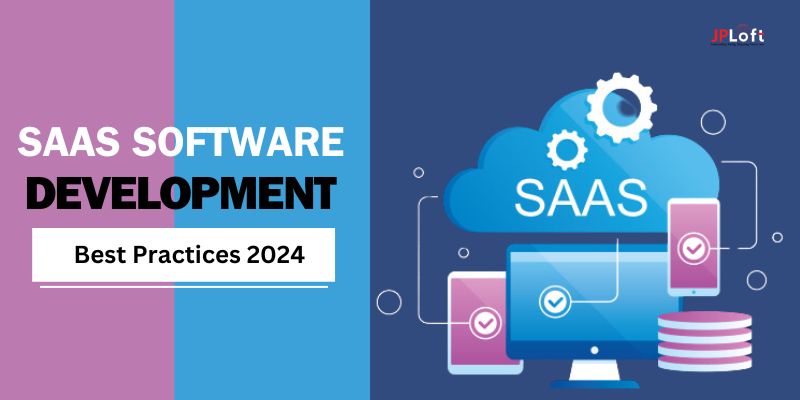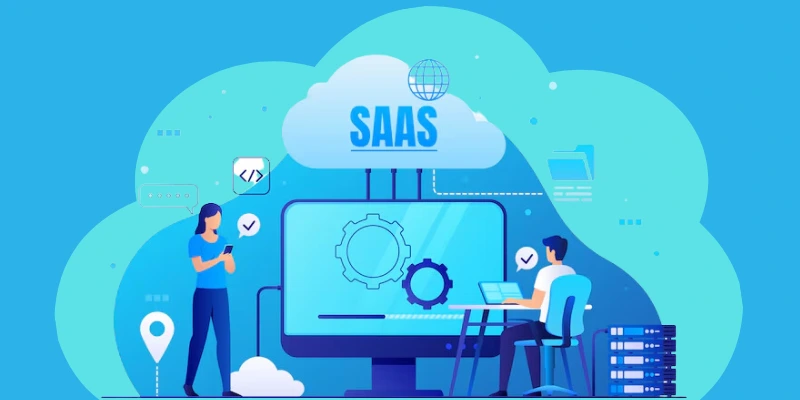Software architects and CTOs are accountable for the creation of new products while improving the efficiency of technology. Your choice of architecture determines the amount of control you can exercise over your infrastructure and data storage requirements and opportunities for customization.
SaaS also frees users of the burden of installing and maintaining Software locally, for example, purchasing, installing, and maintaining it regularly.
Furthermore, SaaS reduces maintenance tasks associated with locally installed Software by installing, installing, and updating. What precisely is the SaaS structure? And why are more companies embracing SaaS applications over on-premise apps?
Let's start by examining SaaS architecture. We will then concentrate on efficient practices to ensure the most efficient, cost-effective concept to support SaaS services.
What Is SaaS Architecture?
Are you interested in SaaS architecture?
Software-as-a-service has quickly emerged as one of the major trends in cloud applications, and will only become more important and sophisticated over time. It's a means of offering Software. Service providers host one or more Software for users to download online.
The SaaS market is proliferating, and the model allows many businesses to join together to share a hosted service, the operating system and hardware network, and many other components.
A business can use the same Software, and engineers can utilize an Application Programming Interface to customize the SaaS solution to meet the demands of their customers.
Purchasing the full software version for installation on every computer you use is unnecessary since SaaS providers can handle each technical issue. The ease of access and the convenience have made it essential for businesses to take on SaaS products in a competitive market. But, it also poses new challenges for technology developers or service suppliers.
What Makes SaaS Development Unique?
SaaS development is distinct in that this is Software that has to be hosted on cloud services that are private or shared in the context. This creates various security issues, performance, compatibility, and user-experience problems that cannot be solved when developing applications that aren't SaaS-based.
SaaS developers must incorporate various cloud security features to ensure their solutions are secure, including Multi-Factor Authorization (MFA),minimum-strength password requirements, encrypted cloud storage, and automatic backup systems.
SaaS developers must also ensure their applications are compatible with modern browsers such as Microsoft Edge on Windows or Safari on Apple iOS/OS platforms. It is also essential to think about other browsers that work on the web, including Chrome, Google Chrome, Mozilla Firefox, and Opera.
Also Read: Top SaaS Startup Ideas for Industries
Another aspect of SaaS applications that distinguishes them is the capacity to grow and decrease the size of the application after its launch. This permits SaaS Development Companies to add or remove third-party features and services, such as plugins, features, and components that were unavailable when they launched their SaaS application.
This implies that SaaS providers can adapt to consumer and market demand by constantly improving their applications even after their initial launch.
SaaS Applications Architecture
Here are a few ideas for SaaS application architectures to help developers develop their applications.
Single-Tenant
Single-tenancy is a term that describes a situation in which each customer uses their version of Software. This SaaS model of development for applications offers more protection than multi-tenancy. However, maintaining and sustaining the application requires more effort.
Serverless Architecture
It can function in two primary capacities: as a Backend-as-a-Service(BaaS),with the application's backend hosted predominantly in the cloud, or as a Function-as-a-Service (FaaS),executing code in response to diverse event triggers. Functions can be activated whenever required, giving businesses several advantages that are too important to miss.
Horizontal SaaS
Horizontal SaaS applications are an excellent fit for many companies regardless of their industry. Examples include accounting and marketing applications that businesses can use in various areas.
Multi-Tenant
Multi-tenancy occurs when a single infrastructure can serve many customers. The data is shared, and every tenant's personal information is protected and kept separate.
Also Read: Cloud-Based Saas Apps
Vertical SaaS
Vertical SaaS applications are, as a result, Software specifically designed to serve specific business sectors. Companies must be able to use the same application across different industries. They are more or less advanced options to be used by other users.
Single-tenant and multi-tenant SaaS architectures, as well as their various design, aren't your only choices. They are considering the best way to build your own SaaS application: a serverless architecture.
The Key Principles in SaaS Architecture
The essential concepts in SaaS architecture design include the capacity to scale, reliability availability, security, performance, and the ability to scale. There are numerous SaaS design principles to be considered, including those provided by AWS's well architected framework. AWS Well Architected Framework is a framework for SaaS applications.
Here's a brief overview of the core principles that drive SaaS architecture.
Support Business Goals
SaaS architecture needs to be designed to serve the purposes and goals of the company. This implies that the structure should be crafted to meet the client's requirements. Any business aims to benefit from satisfying its client's requirements. Thus, the characteristics of the SaaS architecture should be adapted to the user's requirements.
Scalability
SaaS structures must be scalable to handle increasing users and data. This means that the architecture must increase the amount of data and users without creating performance issues. Mainly, it will be able to expand capacity to meet the demands of more users and also automatically save more data without the need for manual intervention or switching to a different platform.
Prioritize Minimum Viability
SaaS must be a minimally viable product, which implies that the architecture has to be constructed to provide the fundamental functions and features with the highest quality and longevity and be able to include additional features in the future. This will reduce the complexity of the structure and decrease the costs of creation, deployment, and maintenance. This approach also ensures that the product can be rapidly launched to the market and will be upgraded gradually over time.
Reliability
Reliability is the term used to describe a device's ability to provide continuous, high-quality performance in terms of reliability, quality and availability, speed, and so on. SaaS Architecture design must ensure the application is up and running throughout the day. This means that the architecture should be designed to reduce the time needed for the application to stop and ensure that users can access the application at any time.
In particular, a reliable and well-hosted application should be designed to detect and fix issues quickly, and the appropriate amount of redundancy must be implemented to ensure no single fault.
Security
Security assures that the system is protected from unauthorized access to data and loss. System security should ensure protection for data from unwarranted access, disclosure, modification and loss. Here's a visual. Instead of monolithic architecture, Microservices architecture can lower the chance of attacks and help distribute security updates only to affected components.
Manageability
SaaS architectures should be easy to manage and maintain. They should be simple to configure, update, and troubleshoot. In addition, the design should be flexible enough to adapt to changes in your company's needs. It is also necessary to separate all the tenant-owned resources. Furthermore, it must offer an open and transparent system for determining who can access what information.
Performance
SaaS architectures are designed to provide users with an excellent experience. Performance is the speed and effectiveness of the system in the achievement of results. The system must be designed to give the most rapid and responsive user experience. Have a look at these examples. The system should limit any interactions that occur between servers and clients. Utilize caching to reduce the response time and use an online delivery platform to increase the speed of responses.
Cost-Effectiveness
SaaS architectures must be cost-effective to maintain and manage compared to IaaS or PaaS services. It should be designed to make the most of resources and associated costs. For example, Amazon Web Services (AWS) SaaS offerings, such as Amazon Connect, an online contact center service, are less expensive than setting up an in-house call center.
Testability
The idea behind tests within SaaS is to manage testing and quality assurance processes for all tenants and customers. However, you'd prefer to establish tests and QA practices across all SaaS apps, not only for particular tenants. But you know that your customers share different user profiles. You can also test a tenant structure on its own before deploying it into multi-tenant structures and ensure it functions correctly and without errors.
Customizability
The SaaS design is intended to reduce the burden of an organization in managing its structures. There's no universally applicable SaaS structure, and the Software should permit users to alter it to fit their requirements. This can be done through APIs or other methods that allow users to modify the system to satisfy their requirements. Furthermore, SaaS architectures should be easy to use and self-service to enable users to create them without assistance.
Compatibility
It is crucial to ensure that your system's diverse devices, users, and configurations can use your SaaS structure design. This will ensure that the Software works appropriately for all device users regardless of their environment.
Alongside supporting a variety of third-party integrations and services, the platform should also allow users to connect to their existing or preferred applications. Adhering to your SaaS structure design guidelines will ensure that the SaaS implementation is compatible with your customers' needs.
Best Practices for SaaS Software Development in 2024
SaaS (Software as a Service) utilizes software applications in a web browser without installing them. SaaS is gaining popularity. The SaaS method is getting increasingly popular with the advent of globalization in technology, and geographical regions are losing importance.
Centralizing To SaaS Operation
Businesses transitioning to SaaS providers signify a significant change in how technology, employees, and processes operate. If organizations switch towards SaaS software development, they need to offer these services as a service, regardless of whether they're within a specific region, industry, or in a particular service. Customers have purchased an entirely managed service up to the most stringent standards. So, they are expected to not point at it and hope it works as intended.
SaaS-based Software removes the need for lengthy installations, quality maintenance, and the ability to help customers and offer periodic updates. These changes impact the operations, finance, and sales departments. Thus, transitioning to a SaaS service provider will force companies to be more centrally controlled, efficient, effective, unified, and efficient in their costs.
Inefficiencies and silos could be impossible to keep up either internally or through a partnership with a third party. To prevent errors and remain up-to-date and relevant in the current cloud era, SaaS application development. The SaaS development process for applications allows businesses to ensure that their configurations are uniform, make use of automation as often as they want, and work effectively.
Hire a Compliance Expert
Ensure the SaaS platform complies with the applicable regional and geographic standards by utilizing certified compliance specialists. If you're outsourcing, ensure it is done so that the SaaS development team is composed of an expert in line with their personnel. They'll conduct the required quality checks to ensure your SaaS platform complies with the most recent standards.
Selecting the Right Methodology
SaaS software developers and providers typically employ different strategies to increase efficiency, reduce time, and increase team cohesion. Before SaaS development of applications commences, the businesses and their SaaS service providers must choose the most appropriate method that is compatible with their strengths and fulfills their business needs. The most popular techniques for SaaS application design include Agile Iterative, Iterative, and Rapid. Let's look at how they differ:
The choice of method you pick must consider the particular specifications for your project. The agile method, the most popular of the three, can enhance your Software's quality and reduce development costs. But it requires a substantial amount of collaboration.
Choose the Right SaaS Architecture
In the initial stages of development, deciding on the appropriate SaaS architecture and platform is essential. There are a variety of frameworks accessible. However, the two most frequently utilized include monolithic architecture and microservices architecture.
Monolithic architecture means the entire SaaS platform is built upon one large codebase. If a change is made to one codebase, it may impact all the codebases and, consequently, needs to be reviewed to avoid interference.
Microservices architecture, on the contrary, means it is a fact that the SaaS platform consists of a range of small code bases (or distinct units) that work in conjunction to make the SaaS platform function effectively.
Developing a Meaningful SaaS Product
SaaS's thriving design and development require an amalgamation of user-centered design, agile methods, security, and continual development. By following these guidelines, you can create a SaaS product that meets user needs and gives you an edge in the market. Be open, flexible, willing to give feedback, and committed to constant improvement to ensure your SaaS product's longevity.
Foster Continuous Improvement
There is always a new SaaS product. It is constantly updated with new features and changes to keep up with recent developments. Promoting a culture that encourages constant improvement within your team members to grow is crucial.
Regularly review and evaluate user feedback, metrics, and user feedback, along with market and industry trends, to discover areas for improvement and innovation. Always look out for ways to improve the quality of your SaaS product. This could include introducing new features and fixing any issues that users may encounter while being ahead of competitors.
Integrations through Third-Party Providers
The digital transformation of businesses involves the digitalization of all aspects of workflow. If you're developing an individual SaaS, look into connecting it with different software platforms.
If you're developing Software for accountants, you may be required to integrate it into analytics and forecasting systems.
When creating Electronic Medical Records (EHR),Thinking about ways to link to bill-payer software, portals, and insurance companies for patients is essential.
Conclusion
The truth is that the SaaS market is expanding. An increasing number of people are becoming aware of the benefits of SaaS development services provided to their daily lives. Small and medium-sized businesses are beginning to see the advantages of Software as a Service can be the ideal solution to meet their requirements. This is why entering the SaaS market today can offer huge potential and advantages shortly. But it's not easy, and you should fully understand how the market functions.
There's no need to install separate Software on each device. Maintenance of the app is easy since the team behind the application will only deliver updates and QoL enhancements to a single cloud-enabled app without requiring users to update their applications manually each time an update is sent out.
Using the above SaaS best practices can help identify and solve the issues customers face and help you accomplish your objective of reducing the rate of churn, enhancing your customers' value over their lives, and boosting retention of customers.
Be flexible, be aware of your customers' needs, and, most importantly, be creative. When you implement the below SaaS best practices into your toolbox, your solution will succeed within a highly competitive marketplace by gaining the attention of customers and a significant market share.
FAQs
1. What will be the main aspects to be considered when creating the most scalable SaaS software by 2024?
In 2024, scalability will remain important. Develop your SaaS software based on microservices using orchestration and containerization tools such as Kubernetes—Automate scaling capabilities to manage the fluctuating demands of users effectively.
2. What role will DevOps have in SaaS Software development by 2024?
DevOps practices facilitate collaboration between operations and development teams, which allows continuous integration and delivery (CI/CD) pipelines. Automated tools like Jenkins and GitLab CI/CD improve effectiveness, allowing for rapid delivery of updates while ensuring the system's stability.
3. What will the importance of the security aspect of SaaS software development be by 2024?
Security is the top priority when it comes to SaaS development. Implement end-to-end encryption, adhere to industry standards such as GDPR and CCPA con, conduct regular security audits, and use multi-factor authentication to protect user data from ever-changing security threats.
4. How do SaaS developers ensure a great user experience for 2024?
Prioritize user-centric design and conduct extensive usability testing to develop easy-to-use interfaces. Make use of data analytics and feedback from users to improve features and solve problems continuously. Implement responsive design to ensure seamless experiences across devices.
5. What are the most effective methods to maintain the compliance of SaaS software development for 2024?
Be informed on any recent regulatory updates, and ensure compliance with the rules that pertain to your market or industry. Implement access control, data anonymization techniques, and regular audits to comply with regulations like GDPR, HIPAA, or SOC 2.
6. How do SaaS developers increase efficiency and reliability for 2024?
Utilize tools for monitoring and profiling performance to pinpoint bottlenecks and increase code efficiency. Use content delivery networks (CDNs) to lower delays and expand your business's reach globally. Use failover and redundancy to limit downtime and assure high availability.
7. What strategies could SaaS developers use to manage data effectively by 2024?
Use cloud-native databases and data storage options such as Amazon RDS, Google Cloud SQL, or MongoDB Atlas to improve the ability to scale and reliability. Create robust backups for your data and disaster recovery methods to protect data from loss and ensure continuity for business.












Share this blog